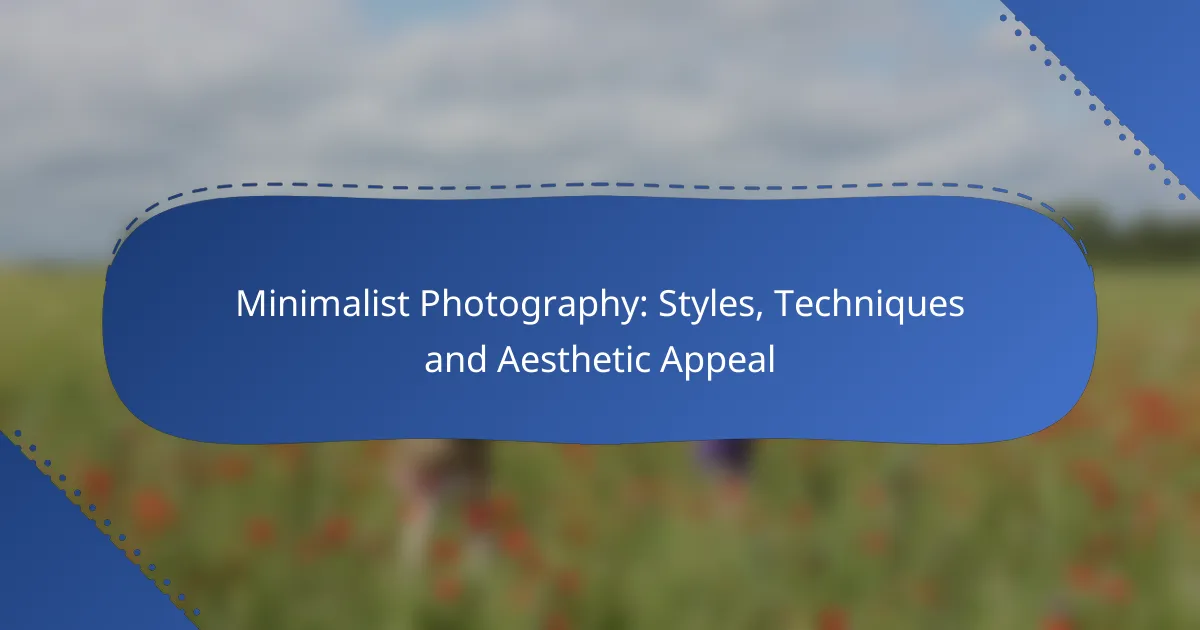Minimalist photography is an art form that emphasizes simplicity by focusing on essential elements and utilizing negative space. By stripping away distractions, this style creates striking images that highlight the beauty of form, light, and composition. Various styles, including black and white, abstract, nature, and architectural photography, each offer unique interpretations of minimalism, inviting viewers to engage with the subject on a deeper emotional level.
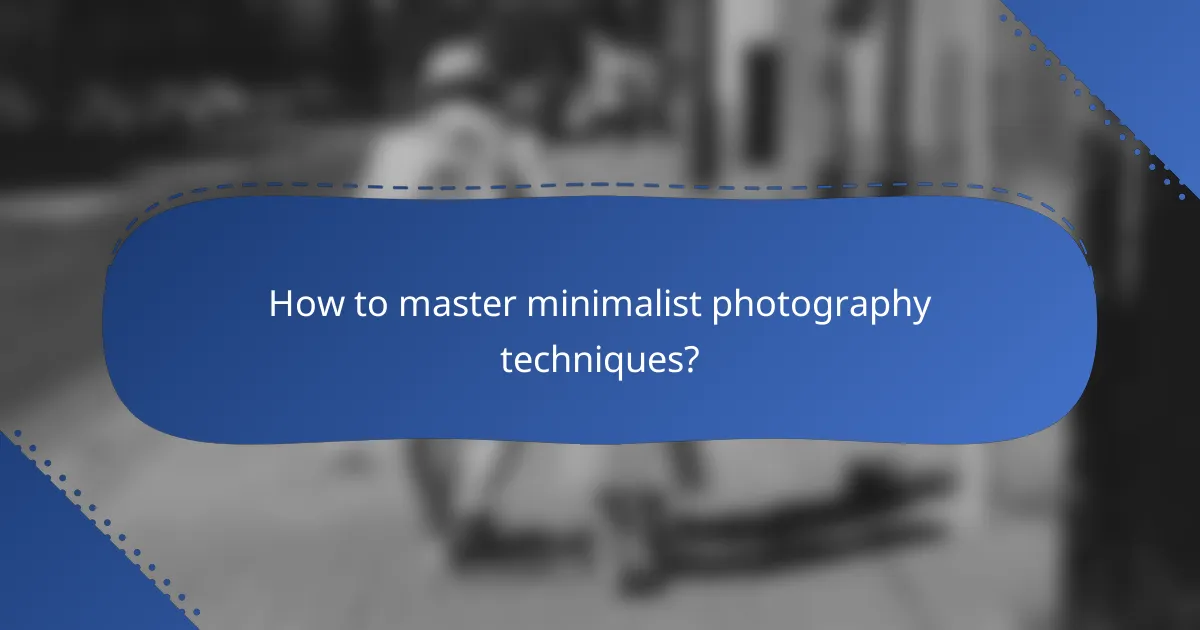
How to master minimalist photography techniques?
Mastering minimalist photography techniques involves simplifying your images to emphasize essential elements. This approach enhances clarity and draws attention to the subject by reducing distractions.
Use negative space effectively
Negative space refers to the area surrounding your subject, which can enhance its prominence. By incorporating ample negative space, you create a sense of balance and focus, allowing viewers to appreciate the subject without clutter.
To use negative space effectively, consider positioning your subject off-center and leaving significant areas of empty space. This technique can evoke emotions and create a more compelling narrative in your photographs.
Focus on simple compositions
Simple compositions are crucial in minimalist photography as they eliminate unnecessary elements. Aim for a clear focal point and limit the number of objects in your frame to create a more impactful image.
One effective method is the rule of thirds, where you divide your frame into a grid and place your subject along the lines or intersections. This technique helps maintain simplicity while guiding the viewer’s eye to the main subject.
Incorporate monochromatic color schemes
Monochromatic color schemes involve using variations of a single color, which can create a harmonious and cohesive look. This approach emphasizes shapes and textures rather than colors, aligning perfectly with minimalist aesthetics.
When choosing a color, consider the mood you want to convey. For instance, soft blues can evoke calmness, while bold reds can create energy. Experimenting with shades and tones can lead to striking minimalist images.
Utilize natural light
Natural light is a powerful tool in minimalist photography, as it enhances textures and shapes without overwhelming the subject. Soft, diffused light, such as during golden hour, can create a serene atmosphere.
To make the most of natural light, observe how it interacts with your subject at different times of the day. Avoid harsh midday sunlight, which can create unwanted shadows and highlights, and instead, aim for softer lighting conditions.
Experiment with framing
Framing involves using elements within the scene to create a “frame” around your subject, drawing attention to it. This technique can add depth and context while maintaining a minimalist approach.
Look for natural frames, such as doorways, windows, or branches, to enhance your composition. Experimenting with different angles and perspectives can also lead to unique and engaging minimalist photographs.

What are the key styles in minimalist photography?
Minimalist photography emphasizes simplicity and the use of negative space, focusing on essential elements to create striking images. Key styles include black and white, abstract, nature, and architectural photography, each offering unique approaches to minimalism.
Black and white minimalist photography
Black and white minimalist photography strips away color to highlight shapes, textures, and contrasts. This style often emphasizes light and shadow, creating a timeless quality that draws attention to the subject’s form. Photographers should consider using strong contrasts and simple compositions to enhance the impact of their images.
To achieve effective black and white minimalist photos, focus on high-contrast scenes, such as a lone tree against a bright sky or a textured wall. Avoid clutter in the frame to maintain the minimalist aesthetic.
Abstract minimalist photography
Abstract minimalist photography focuses on shapes, patterns, and colors rather than recognizable subjects. This style encourages viewers to interpret the image based on form and composition, often leading to a more personal connection with the artwork. Photographers can experiment with angles and perspectives to create intriguing abstract images.
When practicing abstract minimalism, consider using close-ups or unusual viewpoints to emphasize shapes. Look for repetitive patterns or textures that can be isolated to create a sense of depth and intrigue.
Nature minimalist photography
Nature minimalist photography captures the beauty of the natural world while emphasizing simplicity and tranquility. This style often features vast landscapes, solitary elements, or subtle details that evoke a sense of peace. Photographers should aim to highlight the relationship between the subject and its environment.
To create compelling nature minimalist images, focus on wide-open spaces or single subjects, such as a flower in a field or a mountain peak against a clear sky. Utilize natural light to enhance the mood and avoid busy backgrounds that detract from the subject.
Architectural minimalist photography
Architectural minimalist photography showcases buildings and structures with an emphasis on clean lines and geometric shapes. This style often highlights the relationship between light, shadow, and form, creating visually striking compositions. Photographers should consider the balance of elements within the frame to maintain a minimalist approach.
When capturing architectural minimalist images, look for unique angles that emphasize the structure’s design. Use negative space effectively to draw attention to the building’s features, and avoid including distracting elements in the composition.
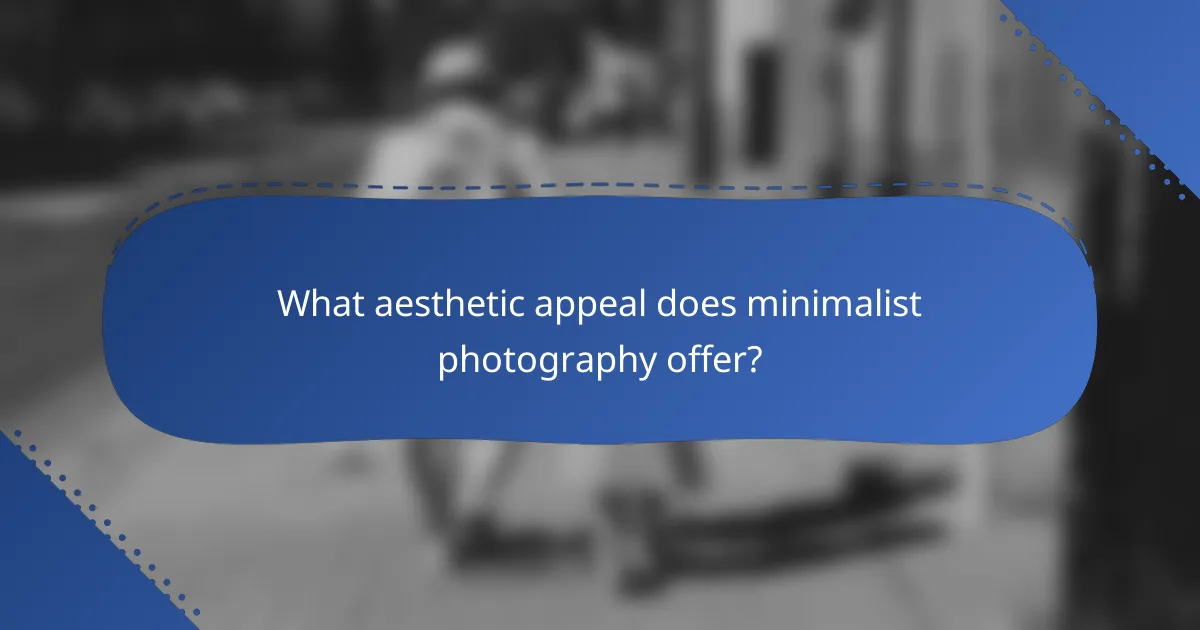
What aesthetic appeal does minimalist photography offer?
Minimalist photography offers a unique aesthetic by focusing on simplicity and essential elements, creating striking images that evoke strong emotions. This style strips away distractions, allowing viewers to appreciate the beauty of form, light, and composition in a more profound way.
Emphasizes simplicity and clarity
Minimalist photography emphasizes simplicity by reducing the number of elements in a frame, which enhances clarity. By using negative space effectively, photographers can guide the viewer’s eye to the subject, making it stand out. This approach often results in images that are clean and easy to interpret.
To achieve this, consider using a limited color palette and avoiding clutter in your compositions. For instance, a single tree against a vast sky can convey a powerful message without unnecessary details.
Creates emotional impact
The emotional impact of minimalist photography stems from its ability to evoke feelings through simplicity. By isolating subjects and using stark contrasts, photographers can create a sense of solitude or tranquility. This emotional resonance is often more profound than in busier compositions.
For example, a close-up of a weathered hand can tell a story of age and experience, while a lone figure in a vast landscape may evoke feelings of loneliness or freedom. The key is to capture moments that resonate with viewers on a personal level.
Encourages viewer interpretation
Minimalist photography encourages viewers to engage with the image and interpret its meaning. By leaving out extraneous details, photographers invite personal reflections and connections, allowing each viewer to derive their own understanding. This open-endedness can lead to a richer viewing experience.
To foster interpretation, consider using ambiguous subjects or compositions that suggest multiple narratives. For instance, a shadow cast on a wall can symbolize various themes, from mystery to hope, depending on the viewer’s perspective. This engagement can make minimalist images more memorable and impactful.
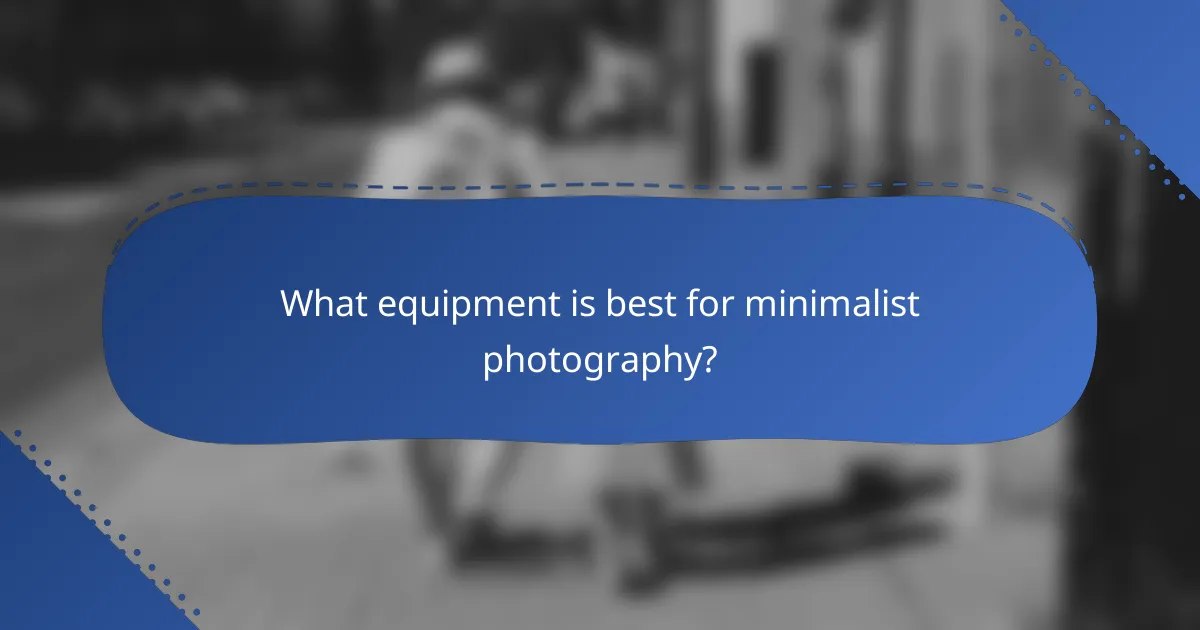
What equipment is best for minimalist photography?
The best equipment for minimalist photography typically includes wide-angle lenses, prime lenses, and sturdy tripods. These tools help capture clean, simple compositions that emphasize the subject while minimizing distractions.
Wide-angle lenses for expansive views
Wide-angle lenses are essential for minimalist photography as they allow you to capture more of the scene in a single frame. This is particularly useful when photographing landscapes or architectural elements where space is limited.
When selecting a wide-angle lens, consider options with a focal length between 14mm and 24mm. These lenses can create a sense of depth and perspective, enhancing the minimalist aesthetic by drawing attention to the main subject.
Prime lenses for sharp focus
Prime lenses, known for their fixed focal lengths, offer superior sharpness and clarity, making them ideal for minimalist photography. A common choice is a 35mm or 50mm prime lens, which provides a natural perspective and excellent image quality.
Using a prime lens encourages careful composition, as you may need to physically move closer or farther from your subject. This can lead to more intentional framing and a stronger focus on minimalism.
Tripods for stability
Tripods are crucial for achieving stability in minimalist photography, especially in low-light conditions or when using slower shutter speeds. A sturdy tripod helps prevent camera shake, allowing for sharper images and more precise compositions.
When choosing a tripod, look for lightweight yet durable options that can support your camera’s weight. Consider features like adjustable height and quick-release plates for ease of use, ensuring you can set up quickly and efficiently.
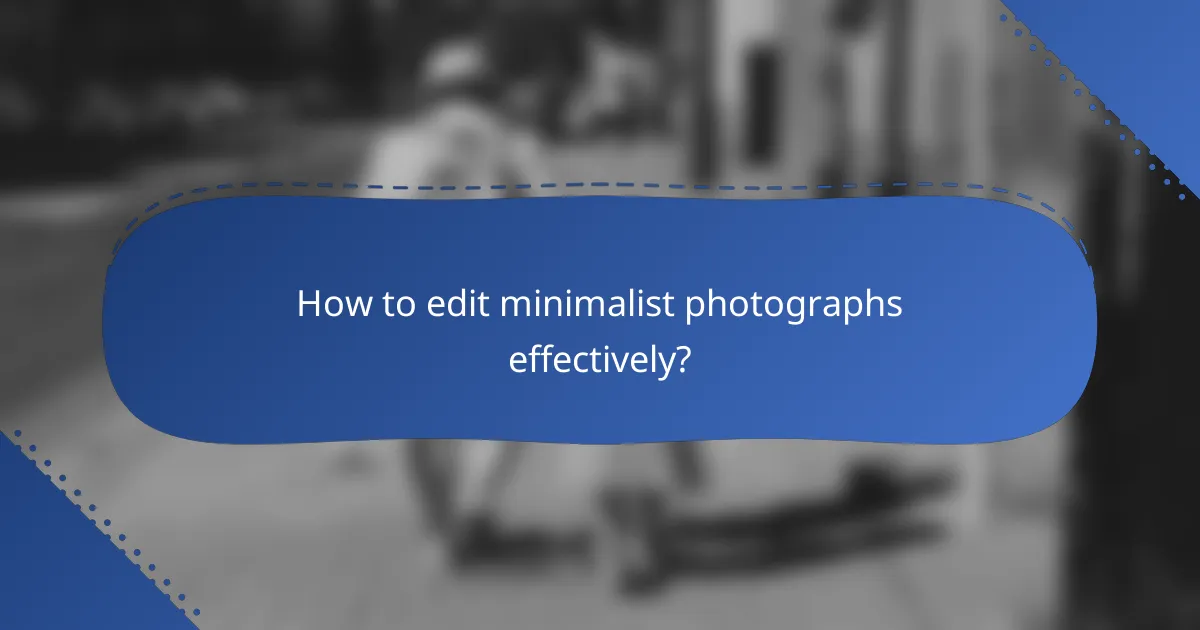
How to edit minimalist photographs effectively?
To edit minimalist photographs effectively, focus on enhancing the simplicity and clarity of the image while maintaining its essential elements. This involves making thoughtful adjustments to contrast, cropping, and color to create a striking visual impact.
Use contrast adjustments
Adjusting contrast is crucial in minimalist photography as it helps to define shapes and emphasize the subject. Increasing contrast can make the subject stand out against a softer background, while reducing it can create a more subdued, harmonious look.
When editing, consider using sliders to find the right balance. A good starting point is to increase contrast by about 10-20% and assess the impact on the overall image. Avoid overdoing it, as excessive contrast can lead to loss of detail in highlights and shadows.
Apply cropping techniques
Effective cropping can significantly enhance the composition of minimalist photographs. Aim to remove any distracting elements that do not contribute to the main subject, thereby drawing the viewer’s eye directly to it.
Use the rule of thirds as a guideline when cropping. Positioning the subject off-center can create a more dynamic image. Additionally, consider experimenting with different aspect ratios to see which best highlights the minimalist aesthetic.
Enhance colors subtly
Subtle color enhancements can elevate minimalist photographs without overwhelming the simplicity of the composition. Use tools to slightly boost saturation or vibrance, but keep changes minimal to maintain the understated feel.
When adjusting colors, aim for a natural look. For instance, enhancing greens in nature shots or softening blues in sky images can add depth. A good rule of thumb is to limit color adjustments to around 5-10% to ensure the image retains its minimalist appeal.

What are the common challenges in minimalist photography?
Minimalist photography often presents challenges such as achieving balance, maintaining interest, and effectively utilizing negative space. Photographers must carefully consider composition and subject matter to convey a strong message with minimal elements.
Finding the right subject
Selecting a compelling subject is crucial in minimalist photography. The subject should be simple yet striking, capable of standing out against a clean background. Common choices include solitary objects, natural elements, or architectural features that evoke emotion or provoke thought.
Utilizing negative space
Negative space is the area surrounding the subject, and it plays a vital role in minimalist photography. Effective use of negative space can enhance the subject’s prominence and create a sense of tranquility. Aim for a balance where the negative space complements rather than overwhelms the subject.
Achieving balance and harmony
Creating visual balance is essential in minimalist photography. This can be achieved through symmetry, asymmetry, or the strategic placement of elements within the frame. Experiment with different compositions to find a harmonious arrangement that draws the viewer’s eye to the focal point.
Maintaining viewer interest
With fewer elements in the frame, maintaining viewer interest can be challenging. Incorporate texture, color contrast, or subtle patterns to add depth and intrigue. Consider using leading lines or shadows to guide the viewer’s gaze towards the main subject.
